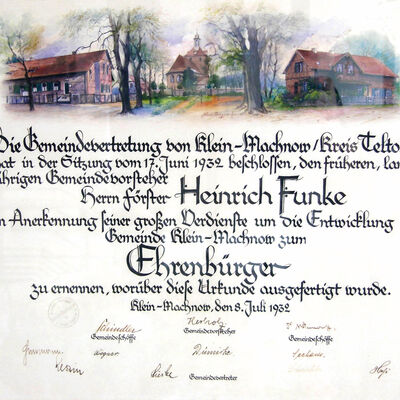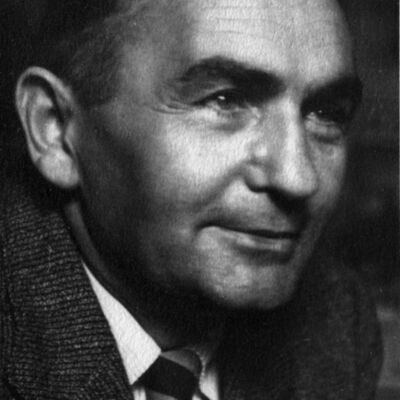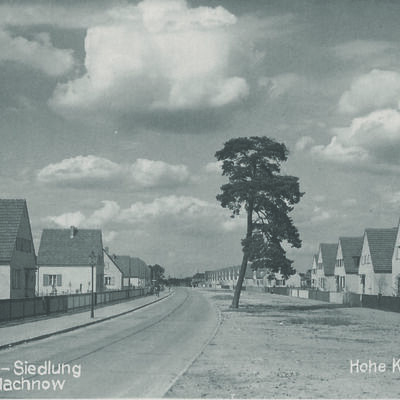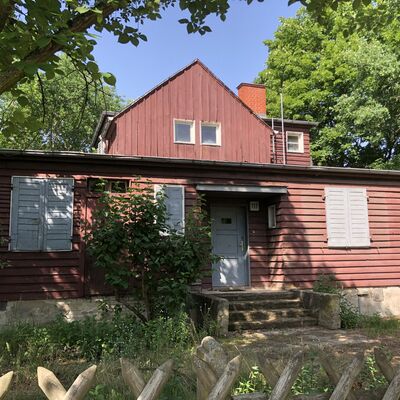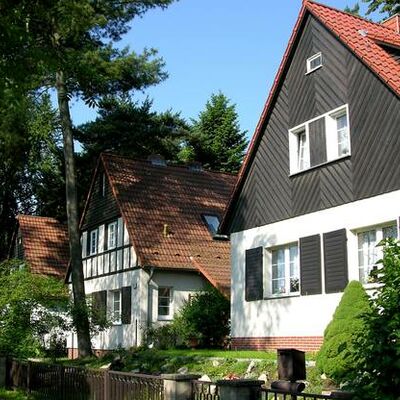
Heinrich Funke (1867 - 1936)
From forester to local councillor
Karl Friedrich Heinrich Funke was born on September 21, 1867 in Trebbin, the son of the innkeeper couple Friedrich Karl Heinrich and Johanna Karoline Emilie Funke from Trebbin. After school and military service, he attended the forestry school in Groß-Schönebeck. On April 1, 1895, he began working as a private forester for Georg and Dietloff von Hake on the Klein-Machnow estate. Two months later, he and his young wife Bertha, née Hoffmann, moved into the idyllically situated Kleinmachnow forester's lodge. He had previously celebrated his wedding on May 18, 1895 in Lübben, the home of his parents-in-law.
When the estate district was dissolved with effect from April 1, 1920 and transformed into the rural municipality of Kleinmachnow, the municipal representatives unanimously elected the previous head of the estate and forester Heinrich Funke as head of the municipality. He was confirmed in office in the 1924 and 1928 elections.
© Wallberg Collection
© Alfred Waßmund
© Harald Kretzschmar
Adolf Sommerfeld (1886 - 1964)
Pragmatist, visionary and persecuted
Adolf Sommerfeld was born on 4 May 1886 in Kolmar, Germany. May 1886 in Kolmar in the province of Poznan. After training as a carpenter, he created a construction group in Berlin, in which he merged several construction and terrain companies under the umbrella of AHAG-Sommerfeld to form a group of companies.
In 1927, Sommerfeld acquired 100 hectares in Kleinmachnow from the large landowner Dietloff von Hake. He began building 150 houses in the Düppelpfuhl section in 1932. Sommerfeld marketed the new district with the Siedlungsgesellschaft mbH Kleinmachnow, of which he was ultimately the sole shareholder. As early as the spring of 1933, Adolf Sommerfeld was persecuted by the National Socialists in Germany: as a Jewish citizen, as a Social Democrat and as a friend and supporter of cultural modernism. Sommerfeld was threatened and ostracized, he had to flee abroad and the settlement was completed under new leadership by 1938 and even celebrated by the National Socialists as an exemplary German colony.
Adolf Sommerfeld - Life and Work
The Berlin master builder, entrepreneur and urban developer thus belongs to a generation that experienced several historical crises and ruptures. Time and again, however, Sommerfeld managed to turn such crises into special success stories; important prerequisites for this were: his own mixture of professional expertise, courage and pronounced pragmatism - as well as imagination, creativity and constantly new ideas.In 1900, Sommerfeld came to Berlin alone at the age of just 14 to learn the carpentry trade. In the following years, he worked as a foreman on large construction sites in the growing city of Berlin - and at the same time graduated from the building trade school in Rixdorf. There, in the neighboring city of Berlin, which was soon renamed Neukölln, he founded his first own construction company in 1910, "Adolf Sommerfeld Bauausführungen", with which he built commercial buildings, synagogues and part of the Wertheim department store on Leipziger Platz in the dense center of Berlin.
During the First World War, construction came to a virtual standstill: only inexpensive, quickly assembled engineering buildings were in demand. The carpenter and master builder Sommerfeld developed large, wide-span hangars in simple timber construction. In times of general hardship, the young entrepreneur's constructively creative products secured him both high recognition and his first commercial success. On this basis, Sommerfeld was able to acquire large areas of building land in Zehlendorf at favorable prices in the early 1920s. Once again, courage, pragmatism and a greater vision were required to turn two million square meters of pine forest on the south-western edge of the city into a residential area for many thousands of people in the following years.
The housing shortage was the big issue at the time. Creating healthy, light, natural housing for as many people as possible was the big goal; and Adolf Sommerfeld wanted to play an active part in this. Initially, he developed affordable and high-quality residential buildings in his timber processing companies east of Berlin. From the outset, he sought to collaborate with particularly good and innovative architects: he built with Erich Mendelsohn, Richard Neutra, Fred Forbat, Otto Rudolf Salvisberg and many others. He had a particularly close professional and friendly relationship with Walter Gropius, who founded the Bauhaus in Weimar in 1919.
From the mid-1920s, Sommerfeld made contact with the large non-profit housing associations, in particular GEHAG and GAGFAH. Together with the city planning councillors Martin Wagner and Ernst Reuter, he developed the new Zehlendorf-Nord district as a major municipal urban development project. The planning of the rapid transit line and a subway station, which was to become both a stopping point and the central supply, cultural and service center of this modern new residential area, preceded the construction of the residential buildings.
Civic housing estate in Kleinmachnow
From 1927, Adolf Sommerfeld acquired a site of around one hundred hectares in Kleinmachnow: the overall urban planning tried and tested in Zehlendorf was to be continued here: Sommerfeld wanted to run the subway line via Mexikoplatz through Kleinmachnow to the Teltow Canal, and a housing estate was to be started along the lines of the ultra-modern Dessau Törten estate developed by Walter Gropius with the Bauhaus.
These plans were thwarted by the global economic crisis in 1929/30. A completely different solution had to be found in Kleinmachnow: with a return to manual construction work, essentially privately financed and intended for private purchase by the end users. The public's taste became the main design criterion, and the townhouse development met it precisely. The affordable detached houses, which were largely adaptable to individual wishes, sold like hot cakes and shaped a new model for suburban living that continues to have an impact today.
For him and his family, difficult years in exile followed: in France, in Palestine and in England. Sommerfeld returned in the early 1950s, cautiously and only temporarily: he lived as an Englishman in Switzerland and had to fight hard for the return of his companies and property in Germany. However, all the difficult and painful experiences of threat, expulsion and marginalization could not destroy his attachment to Berlin: On 4 May 1961, Andrew Sommerfield celebrated his 75th birthday in neighboring Zehlendorf at the "Onkel-Toms-Hütte" pub - opposite the subway station of the same name with the shopping street he had developed.
At the event, Sommerfeld's practical motto was recited:
"Forward the step, plumb in the mitt',
axe sharp into the wood, Sommerfeld's pride."
A close friend and colleague commented accordingly:
Forward the step: The master builder Sommerfeld was always keen to be progressive in building and in his whole being, never standing still, open to everything new, for the benefit of building.
Lot in the middle: A symbol that everything was as it should be, vertical or upright.
Axe sharp in the wood: Both at work, where he himself gripped hard and demanded it from others, and sharp in character or in speech, if necessary.
This motto was also used to honor Adolf Sommerfeld/Andrew Sommerfield on his 125th birthday on May 4, 2011 in Kleinmachnow.
by Celina Kress
Celina Kress is the author of the book 'Adolf Sommerfeld /Andrew Sommerfield, Bauen für Berlin 1910 - 1970'. Together with Nicola Bröcker, she published the book 'Südwestlich siedeln, Kleinmachnow bei Berlin - Von der Villenkolonie zur Bürgerhaussiedlung' (both published by Lukas-Verlag)
Karl-Marx-Straße 22
14532 Kleinmachnow
| Tel. | +49 33203 - 80 379 0 |
| kleinmachnow@von-poll.com |
| Current real estate offers |
| Opening hours |
| Contact |
| Route |

